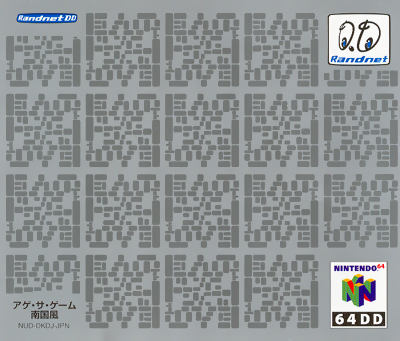
|
| Developer: Param |
| Publisher: Nintendo |
| Released: December 1 1999 |
| Regions: JP |
| Genre: God Game |
| Multiplayer: 1 player |
| Disk Size: 64MB / 512Mbits |
| Saving: Disk |
| Rumble Pak?: Yes |
| Expansion Pak? Yes |
| - Required? Yes |
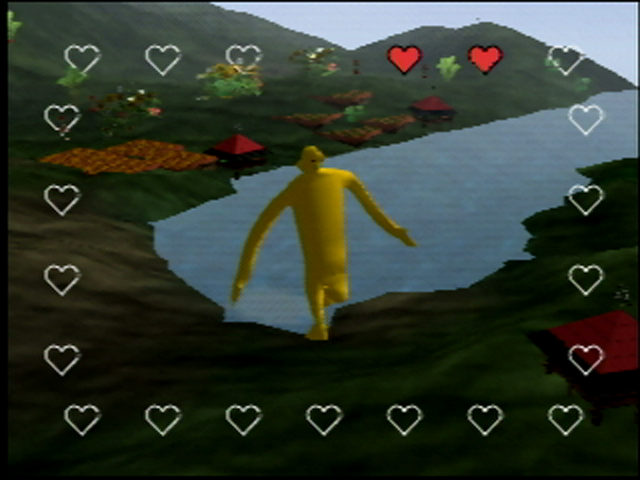
|
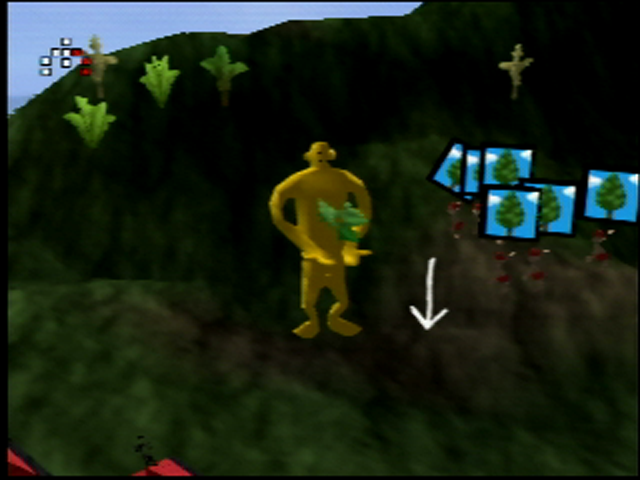
|
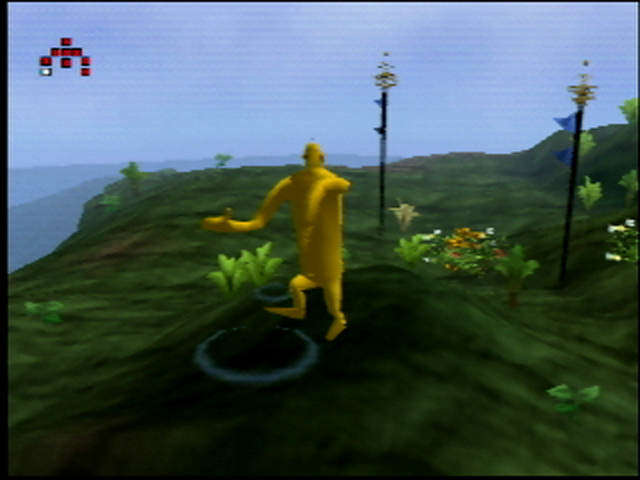
|
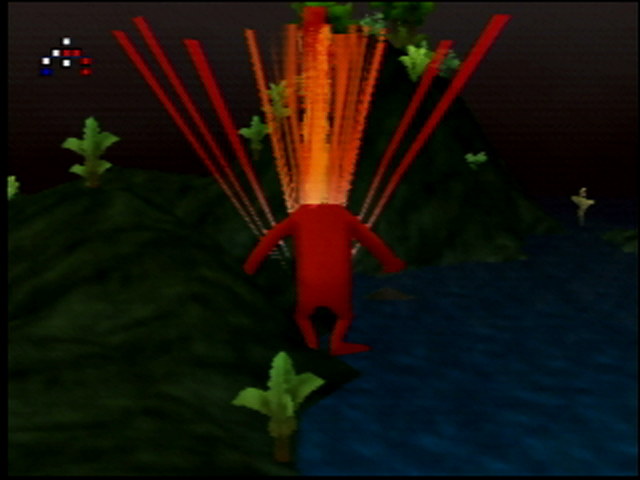
|
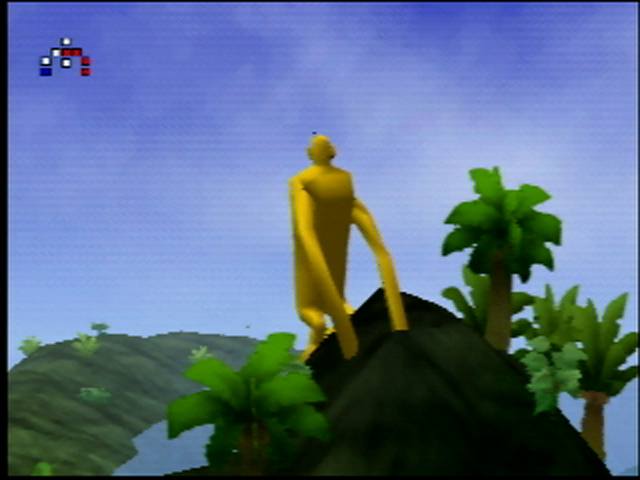
|
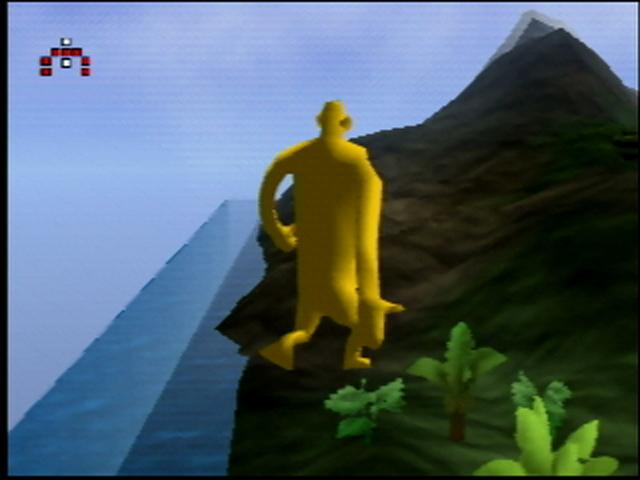
|
A strange, incomprehensible mascot for an equally strange, incomprehensible add-on...
NOTE: This game was only released in Japan. Although it has minimal Japanese text, the entire voice-over is in Japanese. It's somewhat playable as an import, but its appeal to English-speaking gamers is limited.
The N64 had its fair share of oddities in its varied yet meager cartridge library. As weird as it may sound, for all the Space Station Silicon Valleys and Lode Runner 3Ds, none could hold a candle to the tiny assortment of titles belonging to the N64's official add-on console, the 64DD. Although you could easily call almost all 10 released disks "strange", one game in particular holds a special honor in being difficult to describe. That game is Doshin the Giant 1.
This curious little game, often touted in gaming magazines along with rumors of a USA 64DD launch, was one of only two games available when the 64DD finally landed in the hands of Japanese gamers in December 1999. The only other game was Mario Artist: Paint Studio, which was bundled with the official N64 mouse. Doshin the Giant 1 quickly gained noteriety even among English-speaking publications for its odd premise and magical merging of god game simulations and Nintendo design sensibilities. It was even described by its designer Kazutoshi Iida as "Populous meets Mario". During the Japanese 64DD launch blitz, Doshin the Giant (the character) was promoted as the official mascot of the 64DD console. I think it was an appropriate choice, both are weird, hard to describe but lovable in a unique way. Out of the few 64DD games to see the light of day, Doshin the Giant 1 is perhaps the most memorable. In case you're wondering, yes, the game's title is literally "Doshin the Giant 1". The packaging and even the title screen include "1". Like I said, this game is weird...
Before we dive into the game itself, let's go over its technical prowess. As anyone who has played the original 64DD version can attest, Doshin the Giant 1 is always reading and writing to/from the game disk as you terraform the in-game world. One of the game's big selling features was its persistent sandbox world, meaning your individual copy of the game will always remember the changes made in the game world, big and small. In this sense, Doshin the Giant 1 was often touted as a great example of the 64DD's main special feature, its large re-writable floppy disks. It's easy to forget that back in the '90s, home consoles rarely had large amounts of storage space for save files, so games like Doshin the Giant 1 were a rarity at the time. The mythical Ocarina of Time Expansion Disk (aka Ura Zelda) supposedly had a persistent world too.
When you pop in the Doshin the Giant 1 disk for the first time (or erase the save data), you'll be greeted by pretty much only one selectable choice from the main menu, which is the main game. As you play, you'll gain access to statistics about your giant (option 2 from the top), a photo album (option 3), the monument collection screen (option 4) and lastly a save data erase option at the bottom. All of these will be explained as we go over the basics of the game.
In the context of Doshin the Giant 1, the premise concerns a legend that a great god will emerge from the sea and either provide aid or torment the villagers of the land. This idea is one of the core features of the game. By pressing the R button, you can switch between Doshin the yellow love giant and Jashin the red hate giant, essentially alter-egos of the same god figure. By helping the villagers as Doshin, they will give their love to you in the form of hearts. This makes Doshin grow larger. If you prefer to just smash things and be evil, Jashin is an excellent choice, he also grows in size as he causes more mayhem. The end of the day is an important part of the Doshin story too, because as the sun sets, the giant becomes immobile, awaiting the break of dawn the following day. At this time you'll be presented with statistics about your daily activities, you can even top your own personal high scores, like distance traveled and such.
The controls of the game, as explained in Japanese during your first playthrough, are actually rather simple. Moving around is accomplished with the analog stick, any direction on the D-Pad brings up the map. Being a god, you can do some fun things to the rather large map featured in the game. The best of which is either raising or lowering the ground, this is done with the A and B buttons. By pressing B by itself, Doshin/Jashin will reach into the earth, pressing down on the analog stick will make Doshin/Jashin heave the earth up. The A button makes the giant jump, his immense weight actually causes craters to form in the earth. Holding the Z button before using A or B will allow you to raise and lower the ground far faster and more efficiently. Whichever method is up to you. You can also rotate the camera with the C buttons, just like in Super Mario 64. Lastly, the L button takes a snapshot, viewable in the photo album mentioned earlier.
Part of what makes Doshin the Giant 1 weird is it doesn't have an immediately recognizeable objective or goal. To any English speaker, the game consists of roughly 1 hour-long in-game days, in which you can either help or patronize the island villagers to your heart's content. Not a whole lot to do there after a while. As near as I can tell, the goal of Doshin the Giant 1 is getting the villagers to construct monuments. They're very hard to not notice. If any of the villagers anywhere in the world starts building a monument, the camera will immediately focus on the new construction for you to see, no matter where your giant is. You can see which monuments you've collected currently from the 4th option from the top in the main menu. After you've helped or terrorized as many villager tribes as possible, therefore getting every normal monument, eventually they'll construct one big monument to unite all tribes. What happens after that is a bit of a spoiler, so I won't go any further. Let's just say the game does actually have an ending.
That said, much of the strangeness comes from the game itself. As you walk around, slowly, as Doshin or Jashin the Giant, at first it doesn't seem too exciting. Dotted on the map are white squares, these are the villager tribes. You can help them out by moving trees and raising/lowering the ground, or you can destroy their buildings and squish them, either of which will gain you hearts or skulls. Every time you completely fill the ring of hearts/skulls around the screen, Doshin/Jashin will grow in size. The ring of hearts/skulls reminds me a lot of Yoshi's Story actually. As your giant grows, his slow walking speed becomes less of a problem as his walking strides become larger. It takes a while to get there though, this is the kind of game for those with patience. In this context, it's easy to dismiss Doshin the Giant 1 as a boring game.
In terms of visuals and sounds, sadly there isn't much to say. The game doesn't have a whole lot of graphical diversity, just the same ground textures, a few different trees, tiny low polygon villagers, decent looking water effects and of course the village housing and any monuments the villagers have constructed. The game even has a bit of fog in it, kinda underwhelming for a much-hyped 1999 add-on launch title. That said, it's possible the real time terraforming calculations prevented greater graphical diversity. Given this is one of the only N64 games to do this, it's hard to criticize too much.
In terms of music, the game has pretty much just one track, the main theme music you hear at the title screen and whenever you begin a new day. There's also a piece for after the day has ended while your daily scores are tallied, but it's nothing to write home about. Much of the game is spent listening to random rhythmic sound effects from Doshin/Jashin walking around, the villagers and essentially unknown sources, or at least sources I can't identify.
Despite all that, as strange as this is to say, Doshin the Giant 1 has some appeal. No, you're not slaying Ganondorf's evil minions or stomping goombas or even blasting dinosaurs with guns, but Animal Crossing didn't have any of that and it's become a beloved Nintendo franchise. In a similar, albeit far stranger manner, Doshin the Giant 1 has casual quality to it. If you are the kind and loving type, there's something calming and sirene in helping the villagers to rhythmic sound effects. In a simplistic way, it's fun doing terraforming in real time in an N64 game. You can even make your own islands. If you're the mischevious type, you can do equally fun things like turning a village into Atlantis by submerging the whole thing, or just torching structures and villagers alike with streams of fire.
I'm not sure where else to put this, but Doshin the Giant 1 actually has quite the sense of humor. Because the world is one big square, it has edges. Instead of invisible walls or something equally boring, the ocean water just falls off the edge into nothingness. You can quite easily walk right off the side of the world. If you do, a cutscene plays, showing Doshin/Jashin descending haphazardly into the darkness. This is pretty much the only game over present in the game. There's no penalty in doing this besides losing your current daily progress, you'll just be kicked back to the title screen. I never thought I'd one day find a game that makes fun of the flat world theory. Also, Doshin the Giant 1 finally lets me literally make a mountain out of a molehill, thanks to its real time terraforming technology. It may not be a great game, but you can't fault Param for not being original.
In closing, the final question is that of recommendation. Stepping out of the game and back into reality, it's important to remember that Doshin the Giant 1 is a 64DD game. These days, you need to be filthy rich to afford an original 64DD console, much less some games on top. There are alternatives though, thankfully. You could get the Gamecube remake, which was released in Japan and Europe. The Euro translation/localization is really nice actually. The downside is the Gamecube remake is significantly different from the 64DD original, so it's not really the same thing. The only other options are a flash cart running the cartridge port hack, or a PC emulator running a copy of the original disk. If your only option is an original 64DD console, Doshin the Giant 1 alone is definitely not worth the triple digit figures the console tends to go for. As a download or the Gamecube remake, it's at least worth trying out, just for the sheer uniqueness. Although I enjoy playing it, it's not a game for everyone.
On a somewhat unrelated final note, I have been unable to determine whether Doshin the Giant 1 is actually a first party Nintendo game or not. The game's developer is always credited as "Param", no sources specifically confirm if they were a third party outfit. Param was seemingly formed just for the Doshin the Giant games. Also, the packaging for the 64DD version has "RandnetDD" in place of "Nintendo" as the publisher. Randnet was the 64DD online service run by Recruit, under contract for Nintendo. Because of all this, it's hard to compare Doshin the Giant 1 directly with Nintendo's in-house offerings.
Presentation: 7.5
The story and premise may be meager, Doshin the Giant 1 at least gets a few points for sheer originality and uniqueness.
Graphics: 7.0
Doshin the Giant 1 will never win a beauty contest, but it's not outright ugly and the real time terraforming probably prevented significant graphical muscle from being unleashed, so it's hard to criticize too much.
Sound: 7.0
Despite the game being mostly devoid of music, what few tracks it does have at least provide unique identity. The sound effects in game are oddly satisfying.
Gameplay: 8.0
For the first time in human history, you can literally make a mountain out of a molehill! It may not have GTA-levels of sandbox fun, but Doshin the Giant 1 has appeal in a calming sort of way. It's worth playing if only for the real time terraforming feature.
Lasting Appeal: 7.5
After you've obtained all the monuments and seen the ending, there isn't much else to do besides play around in the sandbox world some more.
Overall: 7.4
Written by Aaron Wilcott
January 9 2017
|